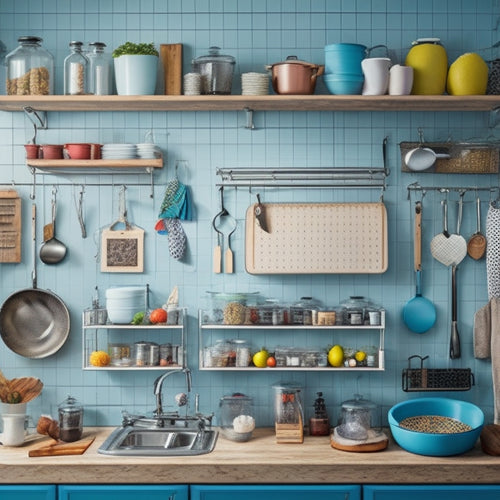
7 Best Kitchen Organization Systems for Busy Families
Share
You're tired of the kitchen chaos that comes with a busy family. To get your kitchen back on track, you need a solid organization system. Start by maximizing cabinet storage with vertical shelving and pull-out drawers. Optimize counter and shelf use with hidden storage options and rotating organizers. Streamline the sink area with faucet organizers and under-sink storage. Effective pantry organization, functional backsplash storage, and a well-designed kitchen island can also make a big difference. Finally, declutter and organize your drawers for a stress-free kitchen experience. By implementing these strategies, you'll be well on your way to a kitchen that runs smoothly and efficiently - and there's even more to discover.
Key Takeaways
• Implement vertical storage solutions and maximize cabinet space to reduce clutter and increase accessibility in busy kitchens.
• Utilize underutilized areas like the backsplash and sink area for additional storage and organization options.
• Create a functional kitchen island with built-in storage and seating to enhance workflow and family interaction.
• Establish a labeling system and allocate specific drawers for each category of items to maintain organization and ease of use.
• Develop a rotation strategy for pantry items to ensure older items are consumed first and reduce food waste.
Maximizing Cabinet Storage Space
You can instantly free up to 30% more cabinet storage space by implementing a few strategic tweaks to your kitchen's current layout. One effective way to do this is by installing vertical shelving, which allows you to make the most of your cabinet's vertical space. This is especially useful for storing infrequently used items, such as special occasion dishes or cookbooks.
Another game-changer is incorporating pull-out drawers, which provide easy access to items that would otherwise be hidden in the back of a cabinet.
In addition to these solutions, you can also utilize under cabinet hooks to hang items like pots, pans, or utensils, keeping them organized and out of the way. Door organizers can also be installed to maximize the storage potential of your cabinet doors.
Optimizing Counter and Shelf Use
By strategically assigning tasks to specific countertops and shelves, busy families can turn these surfaces into productivity hubs that streamline meal prep, cooking, and cleanup. To maximize counter space, consider installing vertical storage solutions like spice racks, knife blocks, or utensil holders. These keep frequently used items within easy reach, freeing up counter space for food preparation.
Next, make the most of your shelves by incorporating hidden storage options. Under shelf baskets, for instance, can store infrequently used items like special occasion dishes or cookbooks, keeping them out of the way but still accessible.
Rotating organizers, such as turntables or Lazy Susans, can be placed on shelves to hold items like oils, condiments, or snacks, making them easy to find and access.
Streamlining Sink and Faucet Area
The sink and faucet area, often a hub of activity in busy kitchens, can be streamlined with thoughtful placement of essential items, such as soap dispensers, sponges, and scrubbers, to reduce clutter and facilitate efficient cleaning. By installing faucet organizers or sink caddies, you can keep these items within easy reach, saving you time and effort.
Under sink storage can also be utilized to store cleaning supplies, trash bags, or other items that you don't use frequently. Countertop caddies can be placed near the sink to hold dish soap, sponges, and scrubbers, keeping them organized and out of the way. This will create a more streamlined look and make cleaning up after meals a breeze.
Additionally, consider using a soap dispenser with a built-in sponge holder to keep your sink area clutter-free. By implementing these simple solutions, you'll be able to maintain a clean and organized sink and faucet area, even on the busiest of days.
Effective Pantry Organization Systems
Moving from the sink area to the core of food preparation, a well-organized pantry is essential for busy families who need quick access to ingredients and cooking supplies. A cluttered pantry can lead to wasted time, expired food, and unnecessary stress. To maximize your pantry's potential, implement an effective organization system that incorporates a labeling system and storage containers.
Here are some strategies to get you started:
| Category | Storage Solution | Benefits |
|---|---|---|
| Grains | Stackable containers | Easy access, visible inventory |
| Canned Goods | Rotating can rack | First-in, first-out rotation, reduced clutter |
| Baking Supplies | Adjustable shelves | Customizable storage, easy retrieval |
| Snacks | Clear bins | Visible contents, easy restocking |
In addition to these storage solutions, consider implementing a rotation strategy to make sure that older items are consumed before newer ones. Regular inventory tracking will also help you identify what you need to restock and what you can donate or discard. By implementing these strategies, you'll be able to find what you need quickly, reduce food waste, and enjoy a more streamlined cooking experience.
Utilizing Backsplash Storage Options
You can reclaim valuable counter space and reduce clutter by incorporating clever storage solutions into your kitchen's backsplash area. This often-underutilized space can be transformed into a functional and stylish hub for storing essential kitchen items.
Here are some ideas to get you started:
-
Vertical storage solutions: Install a pegboard or a magnetic strip to hang frequently used items like spices, oils, or utensils, keeping them within easy reach.
-
Hidden compartments: Create a secret storage space behind a decorative panel or a sliding cabinet door to stash away less frequently used items, such as special occasion dishes or cookbooks.
-
DIY organization hacks: Upcycle an old picture frame into a chalkboard or a corkboard to create a message center or a spot to hang notes and reminders.
- Decorative shelving: Add a floating shelf or a decorative ledge to display cookbooks, decorative plates, or other kitchen decor, keeping them visible but out of the way.
Creating a Functional Kitchen Island
By incorporating a well-designed kitchen island, you'll effectively triple your counter space and gain a central hub for food preparation, storage, and socializing. A multifunctional island design should be your top priority, allowing you to maximize the available space.
Consider an island with built-in cabinets, drawers, or shelves to store cookbooks, utensils, and ingredients. This will keep your countertops clear and create a sense of organization.
When selecting an island, think about your family's needs. If you have kids, opt for an island with stools or seating, making it a family-friendly zone where they can do homework, snack, or socialize while you cook. Look for an island with a built-in breakfast bar or a countertop with a slight overhang, providing ample legroom for your little ones.
A functional island won't only enhance your kitchen's functionality but also become a central gathering spot for your family. By carefully planning your island's design and features, you'll create a space that's both beautiful and practical, perfect for your busy family's lifestyle.
Decluttering and Organizing Drawers
Next, address the often overwhelming task of decluttering and organizing your kitchen drawers, where chaos can swiftly accumulate and make meal prep a nightmare. Developing a system that suits you and your family is crucial, guaranteeing that everything has its designated place.
To begin, follow these steps:
-
Clear out and declutter: Empty your drawers completely and categorize items. Dispose of or donate items that are no longer necessary or useful.
-
Allocate a location: Once you have decluttered, designate a specific drawer or area for each category of items.
-
Utilize drawer separators: Separate your drawers into distinct sections using drawer separators to maintain items organized and easily accessible.
- Establish a labeling method: Label each drawer or section so that all household members are aware of its contents, simplifying the process of upholding your newly organized space.
Related Posts
-

Why Cluttered Kitchens Need Better Tool Storage
You're likely wasting around 30 minutes a day searching for misplaced kitchen tools or utensils, which is equivalent ...
-

Deighton Associates Awarded for Excellence in Asset Management
You're likely curious about Deighton Associates' recent recognition for excellence in asset management. They've recei...

